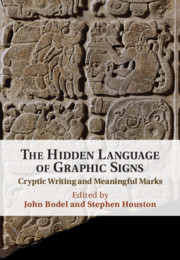Book contents
- The Hidden Language of Graphic Signs
- The Hidden Language of Graphic Signs
- Copyright page
- Contents
- Contributors
- Abbreviations
- Introduction
- Part I Hidden Writing
- One Buried and Camouflaged Writing in Early China
- Two Dazzled and Absorbed
- Three Impossible Unities
- Four Inscribe and De-scribe/Cipher and De-cipher
- Five Script, Pseudoscript, and Pseudo-pseudoscript in the Work of Filippo Lippi
- Six Numerals as Letters
- Part II Legible Signs
- References
- Index
Six - Numerals as Letters
Ludic Language in Chronographic Writing
from Part I - Hidden Writing
Published online by Cambridge University Press: 23 August 2021
- The Hidden Language of Graphic Signs
- The Hidden Language of Graphic Signs
- Copyright page
- Contents
- Contributors
- Abbreviations
- Introduction
- Part I Hidden Writing
- One Buried and Camouflaged Writing in Early China
- Two Dazzled and Absorbed
- Three Impossible Unities
- Four Inscribe and De-scribe/Cipher and De-cipher
- Five Script, Pseudoscript, and Pseudo-pseudoscript in the Work of Filippo Lippi
- Six Numerals as Letters
- Part II Legible Signs
- References
- Index
Summary
Paintings and other objects made in late medieval and early modern European sometimes contain what appears to be highly stylized ornamental writing, often reminiscent of contemporary Arabic scripts but seemingly devoid of linguistic content. Often called pseudo-kufic and now more commonly pseudoscript, these passages of apparently meaningless writing continue to vex historians of art. This chapter aims to advance our understanding of pseudoscript by examining its use in the paintings of the Florentine master Fra Filippo Lippi (c. 1406–1469). A close reading of Lippi’s pseudoscripts, including a few examples in which he surprisingly included legible content, emphasizes that while pseudoscript was a widespread phenomenon, it is perhaps best understood through careful consideration of its particular uses in specific contexts.
- Type
- Chapter
- Information
- The Hidden Language of Graphic SignsCryptic Writing and Meaningful Marks, pp. 126 - 156Publisher: Cambridge University PressPrint publication year: 2021

